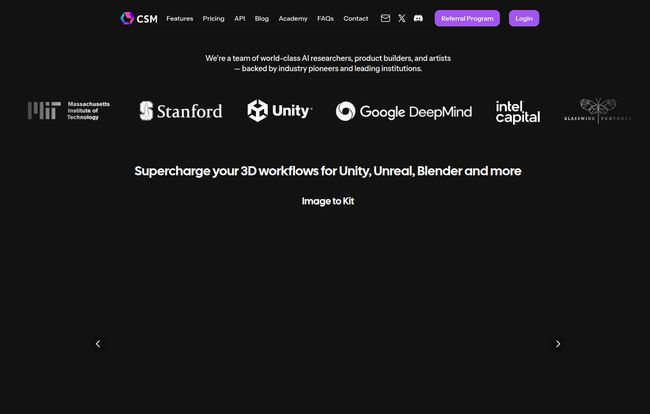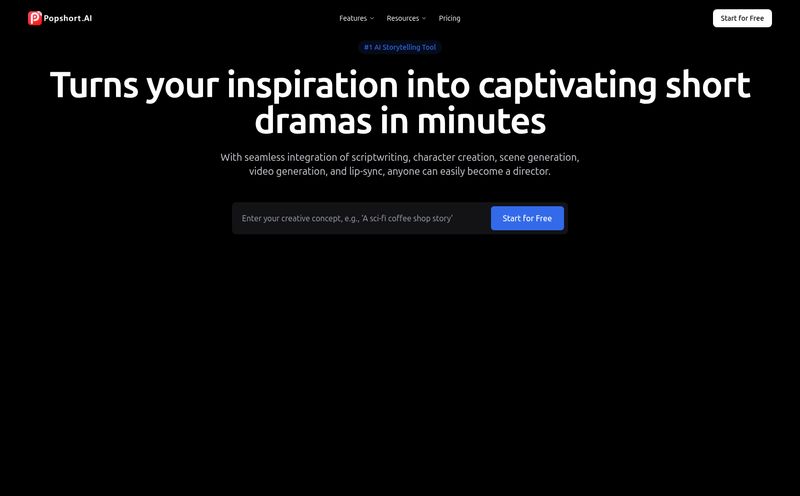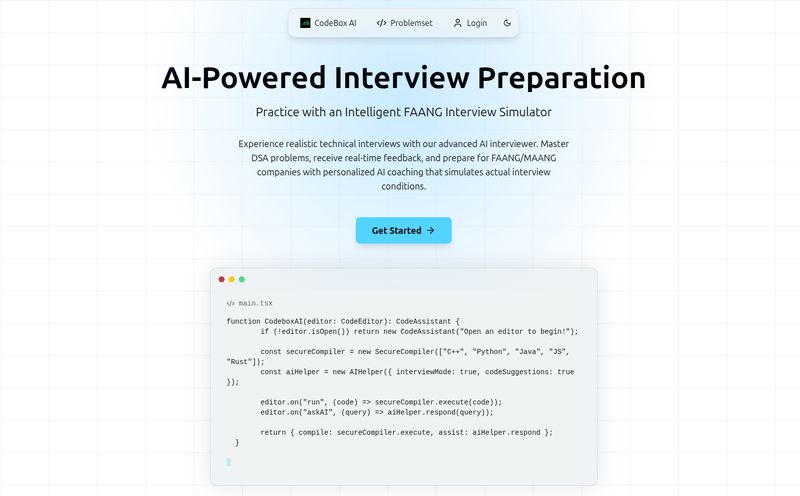I’ve been in the SEO and digital creation game for a long, long time. I’ve seen tools blaze onto the scene promising to change everything, only to fizzle out like a damp firework. So when another AI tool pops up on my radar, my default setting is… skeptical. We’ve all seen the explosion of AI image generators, right? Fun for a bit, but how many of them are actually useful in a professional workflow? That’s the real question.
But then I stumbled upon Common Sense Machines, or CSM. The name itself is intriguing. And the backers? MIT, Stanford, Google DeepMind, Unity… okay, you have my attention. This isn't just some weekend project cooked up in a garage. This felt different. They’re not just talking about making 3D models; they’re talking about creating entire, controllable 3D worlds from simple inputs. Worlds ready for game engines. Now that’s a bold claim.
So, I did what any self-respecting digital tinkerer would do. I rolled up my sleeves and decided to see if CSM is the real deal or just another flash in the pan.
So What is Common Sense Machines, Exactly?
Let's get one thing straight: CSM is not just another text-to-3D generator that spits out a lumpy, unusable mesh. I’ve seen enough of those to last a lifetime. CSM pitches itself as a “3D AI copilot.” I kinda like that. It’s not about replacing artists or developers; it’s about giving them a ridiculously powerful assistant. An assistant that can take a simple text prompt (“a rusty sci-fi cargo crate”), a doodle on a napkin, or even a single photograph and turn it into a game-engine-ready 3D asset.
The core idea is to bridge the gap between imagination and a usable digital object. It’s about speeding up one of the most time-consuming parts of any 3D project: asset creation. Instead of spending hours, or even days, modeling, sculpting, and texturing, you can generate a solid foundation in minutes. That’s the dream, anyway.
The Standout Features That Genuinely Impressed Me
You can talk a big game, but the features are where the rubber meets the road. And CSM has some pretty impressive tricks up its sleeve.
From Literally Anything to a 3D Model
This is probably the biggest hook. Most generative tools are a one-trick pony. CSM is multi-modal, which is a fancy way of saying it accepts different kinds of inputs. You can type a sentence, sure. But you can also upload a reference image, or multiple images for better accuracy. You can even use their Chat to 3D feature, refining your idea through conversation. It’s like brainstorming with an AI that just gets 3D. This flexibility means it can fit into almost any existing creative process, which is a huge plus in my book.
Not Just a Pretty Picture: Production-Ready Workflows
This is the part that separates the toys from the tools. A cool-looking 3D render is one thing; a clean, optimized mesh with PBR textures that you can actually drop into Unreal Engine 5 or Blender is another thing entirely. CSM focuses on generating assets that are production-ready. We're talking about things that have proper topology and materials that react to light correctly. One user I saw on X (formerly Twitter) mentioned this:
"The process turned out to be super efficient. @CSM_ai handled the style surprisingly well, even with batching and some more complex setups like this wagon."
- @suchkanty
That's the kind of feedback that matters. It's being used in real-world scenarios, not just for creating profile pictures.

Visit Common Sense Machines (CSM)
Wait, Did You Say Text-to-4D?
Okay, this is where my jaw dropped a little. Text-to-4D. They are basically letting you generate animation with text prompts through their open-source tools like BlenderMCP. The idea of describing a motion—'a character picking up a box'—and having the AI generate the rigging and animation is, frankly, wild. We are not fully there yet on a push-button Hollywood level, but the fact that it's a core feature they're developing is a massive signal of where this technology is headed. One creator made an animation in just 20 minutes that would have taken hours traditionally. The potential to animate background elements or prototype character movements this way is just staggering.
The Big Question: What's This Magic Going to Cost Me?
Alright, let’s talk brass tacks. Cool tech is great, but if it costs more than my car, it’s not practical for most of us. CSM has a tiered pricing structure that seems pretty well thought out, catering to different users.
| Plan | Price | Who It's For | Key Features |
|---|---|---|---|
| Tinkerer | Free | The Curious | 10 credits to kick the tires, basic generation tools, API access. Content is public (CC BY 4.0). |
| Maker | $20 / month | Indie Devs & Hobbyists | 100 credits/mo, multi-view upload, PBR textures, AI Retexture, private & owned content. |
| Creative Pro | $60 / month | Freelancers & Small Studios | 400 credits/mo, all Maker features, plus priority support and mentoring. |
| Enterprise | Custom | Large Studios & Companies | Unlimited generations, AI Retopology, model fine-tuning, dedicated support, early access. |
The free tier is generous enough to actually test the core functionality. The Maker plan at $20 feels like the sweet spot for most individuals, especially since it makes your creations private. The jump to Pro is a bit steep, but for a team that relies on rapid asset creation, 400 generations and priority support could easily pay for itself.
The Good, The Bad, and The AI-Generated
No tool is perfect. After spending some time with it, here's my breakdown.
On the plus side, the controllability is fantastic. Being able to guide the AI with multiple inputs makes a world of difference. The focus on production-ready assets isn’t just marketing fluff, it’s a genuine design philosophy. And having a team with that kind of academic and industry pedigree inspires a lot of confidence.
On the other hand, the best features, like AI Retopology and unlimited generations, are locked behind that custom Enterprise plan. That’s understandable from a business perspective, but it does mean solo creators might hit a ceiling. And while the AI is good, it’s not a mind reader. You still need a good creative eye and the ability to write effective prompts to get great results. It wont just hand you a masterpiece without some effort on your part.
Final Thoughts: Is CSM the Future?
So, back to my original question. Is CSM the real deal? Yeah, I think it is. It's one of the most promising and professionally-oriented 3D generative AI platforms I’ve seen.
It's not going to put 3D artists out of a job. Let's just put that tired argument to bed. What it will do is change the job. It's a force multiplier. It automates the grunt work—the endless blocking out, the basic texturing, the prototyping. This frees up artists to focus on what humans do best: the final polish, the art direction, the storytelling, the soul of a project.
Think of it as the leap from hand-drawing every frame of an animation to using digital tools. The art didn’t die; it just became possible to create more, faster, and at a higher fidelity. CSM feels like that kind of step. It’s a powerful copilot, and for anyone in the 3D space, it’s absolutely worth taking for a test flight.
Frequently Asked Questions about CSM
- Can I use assets made with CSM for commercial projects?
- Yes, on the paid plans (Maker and above). On these plans, the content you generate is private and you own it. The free Tinkerer plan licenses content under a Creative Commons license, which has different requirements.
- What kind of files does CSM export?
- CSM is designed for compatibility, exporting formats like GLB, FBX, and OBJ, which are standard for major game engines like Unity and Unreal, as well as 3D software like Blender.
- Do I need to be a 3D expert to use CSM?
- Not at all! That's kind of the point. A basic understanding of 3D concepts helps, but you can generate impressive assets with just text or image inputs. However, to get the most out of it in a professional pipeline, 3D skills are definitely beneficial.
- How good is the AI Retexturing feature?
- It's pretty powerful. You can take an existing untextured model and apply a new material just by describing it. For example, you could take a generic sword model and tell it to “make it an ancient, moss-covered stone sword” and it will generate the appropriate PBR textures.
- Is CSM better than other 3D AI tools on the market?
- "Better" is subjective. Some tools might be faster for a quick, low-poly model. But CSM's strength lies in its focus on controllable, production-ready assets and its multi-modal input system. For professional workflows, I believe it's one of the top contenders right now.
- What exactly is Text-to-4D and how does it work?
- Text-to-4D is the process of generating 3D animation (the 4th dimension being time) from a text prompt. CSM achieves this with tools like their BlenderMCP add-on, which uses AI to interpret a text command and apply it as an animation to a 3D model's rig within Blender.



